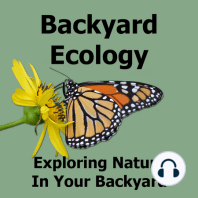53 min listen
5 Native Plants that Bloom in the Late Fall
FromBackyard Ecology
ratings:
Length:
23 minutes
Released:
Oct 13, 2022
Format:
Podcast episode
Description
One of the most common pieces of advice given related to pollinator gardening is to try and have a constant supply of blooms available throughout the growing season. That’s easy in the spring. The summer is a little more challenging than the spring, but is still relatively easy. Even early fall isn’t too bad thanks to the goldenrods, ironweeds, and other fall flowers. It’s the shoulder seasons that are the most challenging for providing flowers for pollinators. By shoulder seasons I mean the late winter / early spring and the late fall / early winter. For me, that typically corresponds to February / March and October / November. Your shoulder seasons may occur at slightly different times depending on how far north or south you live and your elevation. One of the reasons that the shoulder seasons are difficult is because the weather is so crazy at that time. Most flowers just can’t take the cold temps, frosts, and freezes that are often associated with the shoulder seasons. However, there are a few native plants that can handle the crazy weather of the shoulder seasons. I’m recording this in October, so I’m going to focus on native plants that bloom in the late fall /early winter shoulder season, or the October / November time period. On a side note, if the weather is good, many of our goldenrods, white fall asters, thoroughworts, and other fall flowers will bloom well into October. However, most of those flowers will be killed off with the first good frosts. The native plants that I’m focusing on in this episode are the ones that typically don’t start blooming until around October and that can survive those first frosts after most of the earlier blooming fall flowers are gone. To make it easier for you to refer back to particular parts of the podcast, here are the plants and the time I start talking about each: American witch hazel (Hamamelis virginiana): 4:39 Short’s aster (Symphyotrichum shortii) and Wavy leaf aster (Symphyotrichum undulatum): 8:05 Tickseed sunflower (Bidens aristosa): 12:24 American mistletoe (Phoradendron leucarpum): 15:03 Links: Relevant Backyard Ecology blog articles and podcast episodes: American Witch Hazel: The Last Flowers of the Year: https://www.backyardecology.net/american-witch-hazel-the-last-flowers-of-the-year/ Short’s Aster: https://www.backyardecology.net/shorts-aster/ Wavy leaf aster – A late feast for pollinators: https://www.backyardecology.net/wavy-leaf-aster-a-late-feast-for-pollinators/ American Mistletoe – A Holiday Plant Enjoyed by Pollinators and Wildlife: https://www.backyardecology.net/american-mistletoe-a-holiday-plant-enjoyed-by-pollinators-and-wildlife/ Remember the Shoulder Seasons when Planting for Pollinators: https://www.backyardecology.net/remember-the-shoulder-seasons-when-planting-for-pollinators/ 5 Fall Blooming Native Plants I Love: https://www.backyardecology.net/5-fall-blooming-native-plants-i-love/ Busy Bee Nursery and Consulting: https://busybeenurseryandconsulting.com/ Backyard Ecology Website: https://backyardecology.net Backyard Ecology YouTube Channel: https://www.youtube.com/backyardecology Backyard Ecology Blog: https://www.backyardecology.net/blog/ Backyard Ecology Patreon page: https://www.patreon.com/backyardecology Subscribe to Backyard Ecology emails: https://www.backyardecology.net/subscribe/ Episode image: Tickseed sunflowers Photo credit: Becky, cc-0
Released:
Oct 13, 2022
Format:
Podcast episode
Titles in the series (92)
Native and Non-native Earthworms in the Eastern U.S. with Mac Callaham: Earthworms in the Eastern U.S. by Backyard Ecology
